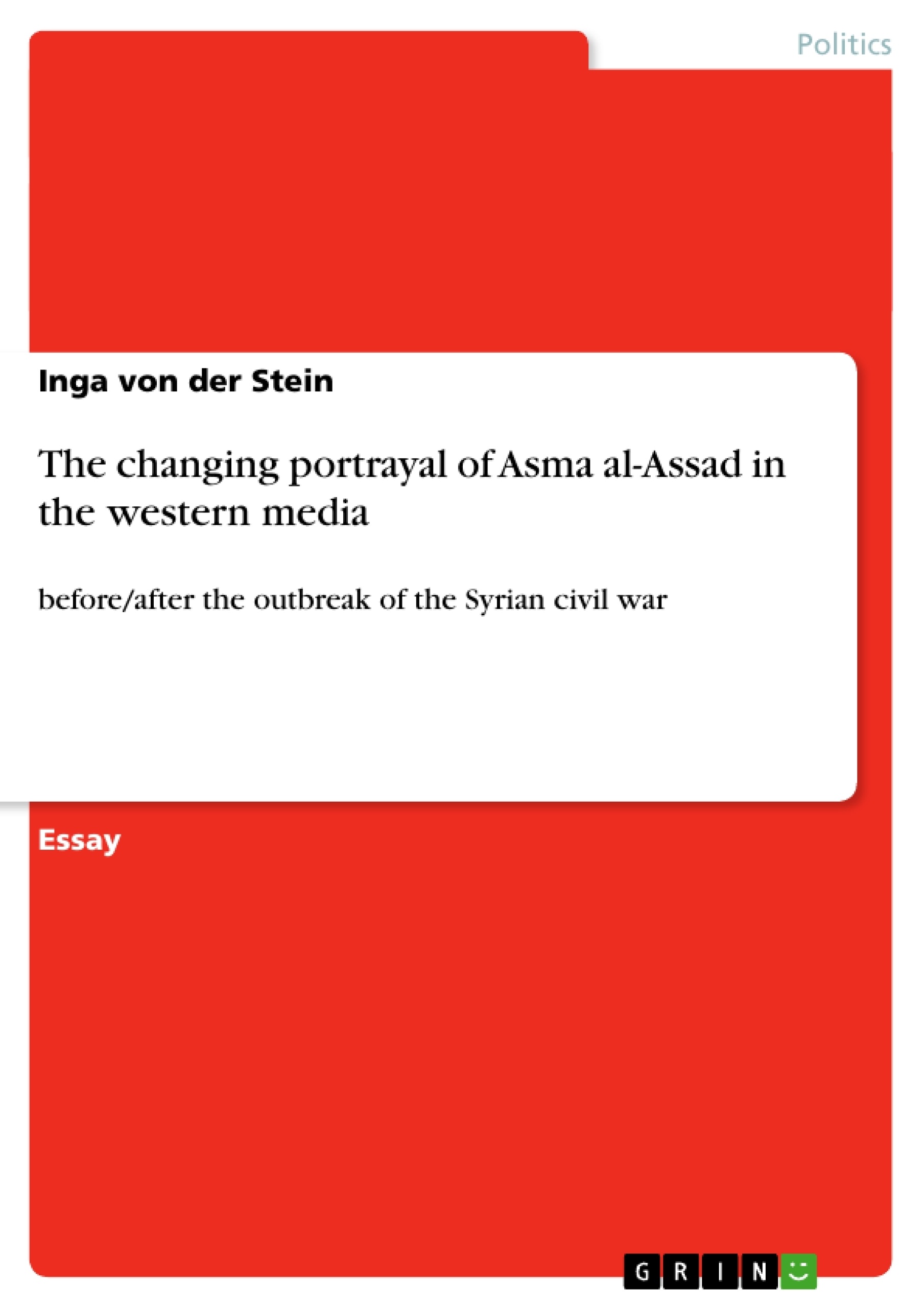Excerpt
1 Introduction
Over the past two years, the civil war in Syria has been one of the major topics in Western media. It began in 2011 with demonstrations against the Assad regime. It is estimated by the United Nations that over 100,000 have died and millions have been displaced since then (Tomasevic, 2013). One of the major focuses set by the media is on Bashar al-Assad, the current President of Syria, who is called upon by many in- and outside the country to resign (Wilkinson & Smith-Spark, 2013). In the early terms of his Presidency, Assad symbolized a sign of hope for a more modern and democratic Syria – a significant factor was his wife, born and educated in Great Britain, who spoke out publicly for human rights and peace. The two were represented as a glamorous and westernized couple by the press throughout the years. This perception abruptly changed with the uprisings in Syria which have begun in March 2011 (Goodspeed, 2012). However, Bashar al-Assad’s wife, Asma, is still portrayed as a caring First Lady by social media such as instagram and facebook used by the Assad Regime (Dewey, 2013). As a result of her presentation as a liberal and peace-aiming figure in the past, many, in particular women, still hope that the country’s First Lady will stand up against violence, however, she remains silent until this point (“UN ambassador wives”, 2012).
One wonders, how such a positive and one-sided depiction of Asma al-Assad in the Western media was achieved in the first place? Who was holding the reins for this? And why were the journalists more absorbed by her outward appearance than by the fact that she is the wife of a dictator? These are questions this paper examines. Therefore, I studied Western media, in particular fashion magazines, tabloids but also well-respected newspapers such as the Guardian or the Washington Post in order to give my reader a varied overview of the way Asma al-Assad was represented in different tubes of the Western press. The answers serve to consider what the contrasting portrayal of Asma al-Assad can reveal in general about the accuracy and the function of the media in the West, being influenced both by propaganda and the interests of the Western readership. This is why I laid my focus on the portrayal of Asma al-Assad in the Western media, comparing her depiction before and after the outbreak of the civil war in Syria. I have structured this paper into two parts to demonstrate the disparity of her representation in the media in this context. The first part concentrates on Asma al-Assad’s media portrayal in the time frame of her becoming Syrian’s First Lady in 2000 until the outbreak of the Syrian civil war. The second part investigates how this positive depiction swiftly turned into a negative one after the start of civil war in 2011, trying to point out additionally the reasons for this sudden inversion.
2 The media portrayal of Asma al-Assad
2.1 Before the outbreak of civil war in Syria
“Champion of women’s rights” (Fantz, 2012), “Syria’s Princess Diana” (Bennet, 2005), “A rose in the desert” (Fisher, 2011).
This is only a small choice of the flattering names the Western press entitled Asma Al-Assad with in recent years. Being born as Asma Akhras to a Syrian family living in England, the young Asma was shaped by the lifestyle of the West. Despite her Muslim faith, she visited a local Church of England school. Then, after attending King’s College in London, she worked with huge success as an analyst for JP Morgan and the Deutsche Bank (“Road to Damascus”, 2001). Therefore, one could say that she followed the career of the ‘ideal’ western woman.
Her background story was one of the reasons why she was portrayed in the media as a “progressive face” when she moved to Syria in 2000, marrying Bashar al-Assad, who had just become the President of Syria six months earlier (Goodspeed, 2012). Following this, her public presence has grown significantly as she was seen regularly on state duties with her husband. Soon she gained the status of a Western-styled fashion icon. Photographs of her could usually be found in fashion magazines, often being compared to Queen Rania of Jordan, who is also seen as an example of a modern woman in the Arab World. Occasionally her elegant performance even outweighed political issues, giving her husband a spark of her glamor. For example, the New York Times described the couple in 2005 as “the essence of secular Western-Arab fusion” (Fantz, 2012).
In 2009, the American online newspaper the Huffington Post published a slide show on Asma Al-Assad, calling her “Syria’s First Lady and All-Natural Beauty” (Akkad, 2010, Huffington Post). In addition, she was named as one of the best-dressed women in politics in 2008 by the world’s best- selling fashion magazine Elle in France (Goodspeed, 2012).
[...]
- Quote paper
- Inga von der Stein (Author), 2013, The changing portrayal of Asma al-Assad in the western media, Munich, GRIN Verlag, https://www.grin.com/document/264962
Publish now - it's free






















Comments